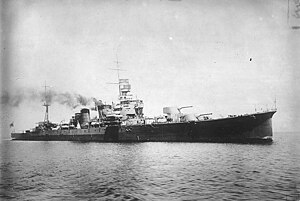Japanese cruiser Kako

Heavy cruiser Kako in 1926
|
|
| History | |
|---|---|
|
|
|
| Name: | Kako |
| Namesake: | Kako River |
| Ordered: | 1923 Fiscal Year |
| Laid down: | 5 December 1922 |
| Launched: | 10 April 1925 |
| Commissioned: | 20 July 1926 |
| Struck: | 15 September 1942 |
| Fate: |
|
| General characteristics | |
| Class and type: | Furutaka-class heavy cruiser |
| Displacement: | 7,950 tons (standard) |
| Length: | 176.8 m (580 ft 1 in) |
| Beam: | 15.8 m (51 ft 10 in) |
| Draught: | 5.6 m (18 ft 4 in) |
| Propulsion: |
|
| Speed: | 34.5 knots (64 km/h) |
| Range: | 7,000 nautical miles (13,000 km) at 14 knots (26 km/h) |
| Complement: | 616 |
| Armament: |
|
| Armor: | |
| Aircraft carried: | 1 x floatplane, 1 catapult |
Kako (加古 重巡洋艦 Kako jūjun'yōkan?) was the second vessel in the two-vessel Furutaka class of heavy cruisers in the Imperial Japanese Navy. The ship was named after the Kako River in Hyogo prefecture, Japan.
Kako and her sister ship Furutaka were the first generation of high speed heavy cruisers in the Japanese navy, intended to counter the US Navy Omaha-class scout cruisers and Royal Navy Hawkins-class heavy cruisers.
Kako was completed at Kawasaki Shipbuilding Corporation at Kobe on 20 July 1926. Assigned to the Fifth Squadron (Sentai) from then until 1933, she served in Japanese and Chinese waters, participating in fleet maneuvers and combat operations off the China coast. Kako was given a major refit in 1929–30, improving her machinery and slightly changing her appearance. Briefly operating with Cruiser Division 6 (CruDiv6) in 1933, Kako was in the naval review off Yokohama in late August. She went into guard ship status in November of that year and into reserve in 1934.
In July 1936, Kako began an extensive reconstruction at Sasebo Navy Yard, which was completed by 27 December 1937. At this time, the ship's six single 200 mm (7.9 in) main gun turrets were replaced by three 203.2 mm (8 in) twin turrets.
In late 1941, Kako was in Cruiser Division 6 under Rear Admiral Aritomo Goto in the First Fleet with Aoba, Furutaka and Kinugasa. At the time of the attack on Pearl Harbor, she was engaged in support for the invasion of Guam.
...
Wikipedia
